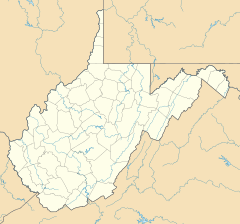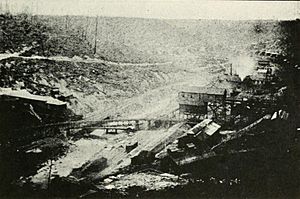Coketon, West Virginia facts for kids
Quick facts for kids
Coketon
|
|
|---|---|
| Country | United States |
| State | West Virginia |
| County | Tucker |
| Time zone | UTC-5 (Eastern (EST)) |
| • Summer (DST) | UTC-4 (EDT) |
| GNIS feature ID | 1554170 |
Coketon is a small community in West Virginia, USA. It's not a city with its own government, but a place where people live. It was once a busy coal town. Coketon is located where two streams, Snyder Run and the North Fork Blackwater River, meet. It is just south of the town of Thomas.
Contents
Coketon's Coal Mining History
Coketon was started by the Davis Coal & Coke Company. This happened in the 1880s. Large amounts of coal were found in the area. Henry G. Davis led the company.
Life in a Coal Town
At its busiest, Coketon was home to about 1,500 people. Many of these residents were immigrants. From 1915 to 1921, the 15 mines near Coketon were very productive. They shipped over 1 million tons of coal each year. This made Coketon the sixth most productive mining area in West Virginia.
The Rise and Fall of Coke Ovens
The Davis Coal & Coke Company was a pioneer in making "coke." Coke is a cleaner fuel made from coal. They used large, sealed "beehive" ovens. These ovens heated coal to burn off impurities. The company first tried two ovens in 1887. By 1900, there were over 600 beehive ovens.
However, new technology changed how steel was made in 1915. This meant coke ovens were no longer needed at the mine. By 1919, no more coke was being made in Tucker County. The many beehive ovens became unused.
Decline of Coal Production
After the coke ovens closed, coal mining in Coketon also slowed down. From the 1920s to the 1940s, the coal underground started to run out. As less coal was mined, the mines closed. The number of people living in Coketon slowly went down. By 1950, only two mines were still working. They produced much less coal. By 1956, all underground mining had stopped. Some surface mining continued until 1965.
A Landmark Civil Rights Case
Coketon was important in a civil rights case in 1892. This case involved the Coketon Colored School. The local school board told the teacher, Carrie Williams, to teach for three months less. This was shorter than the school year for white schools.
Carrie Williams' Fight for Equality
Carrie Williams bravely continued teaching for the full eight months. She then demanded her full pay. Her lawyer was J.R. Clifford. He was a famous civil rights activist. He was also the first African American lawyer in West Virginia.
A Victory for Justice
The case began in the Tucker County Courthouse. It eventually went all the way to the West Virginia Supreme Court. Carrie Williams and J.R. Clifford won the case. This victory was very important. It was the first civil rights case in U.S. history to say that treating people differently because of their skin color was against the law.
See also
 In Spanish: Coketon (Virginia Occidental) para niños
In Spanish: Coketon (Virginia Occidental) para niños




